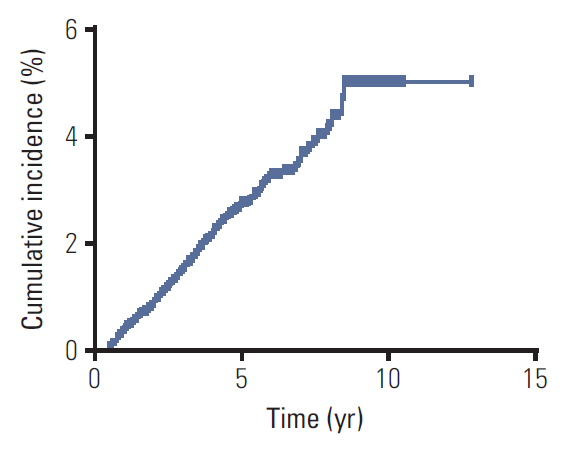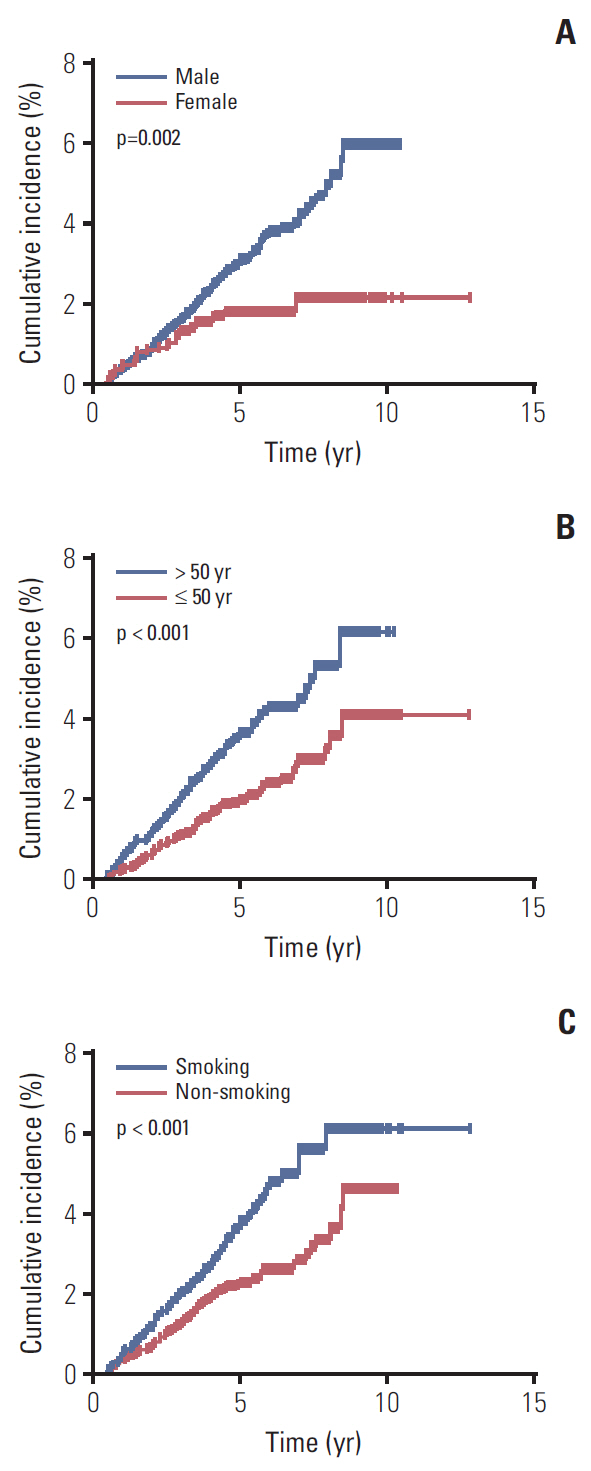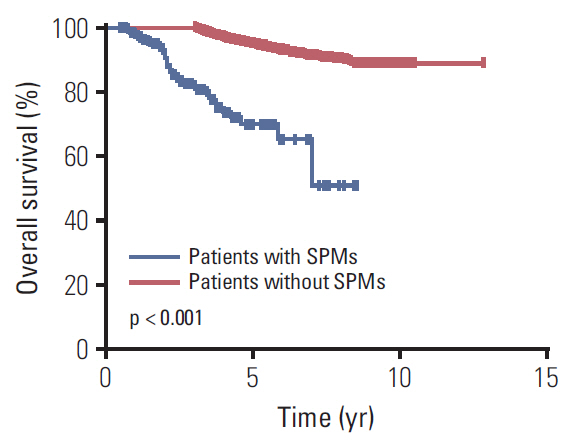Cancer Res Treat.
2019 Jul;51(3):982-991. 10.4143/crt.2018.298.
Risk Assessment of Secondary Primary Malignancies in Nasopharyngeal Carcinoma: A Big-Data Intelligence Platform-Based Analysis of 6,377 Long-term Survivors from an Endemic Area Treated with Intensity-Modulated Radiation Therapy during 2003–2013
- Affiliations
-
- 1Department of Radiation Oncology, Sun Yat-sen University Cancer Center, State Key Laboratory of Oncology in South China, Collaborative Innovation Center for Cancer Medicine, Guangzhou, China. sunying@sysucc.org.cn
- 2Department of Radiology, Guangdong No.2 Provincial People’s Hospital, Guangdong Provincial Emergency Hospital, Guangzhou, China.
- 3Department of Oncology, the First Affiliated Hospital of Guangdong Pharmaceutical University, Guangzhou, China.
- 4Department of Medical Statistics and Epidemiology, School of Public Health, Sun Yat-sen University, Guangzhou, China.
- KMID: 2454290
- DOI: http://doi.org/10.4143/crt.2018.298
Abstract
- PURPOSE
The incidence, risk factors and survival impact of secondary primary malignancies (SPMs) among survivors of nasopharyngeal carcinoma (NPC) treated with definitive intensity-modulated radiation therapy (IMRT) with or without chemotherapy are poorly characterized.
METHODS
AND MATERIALS: Consecutive patients (n=6,377) from the big-data intelligence platform at Sun Yat-sen University Cancer Center, China (in a high-incidence area) with newly diagnosed non-metastatic pathologically proven non-keratinizing undifferentiated NPC treated with IMRT±chemotherapy between January 2003 and June 2013 were retrospectively analyzed. Cumulative incidence of SPMs was calculated using the Kaplan-Meier method. Cox proportional hazards model was used to identify potential risk factors for SPMs and assess whether SPMs affect overall survival.
RESULTS
Of the 6,377 patients, 189 (3.0%) suffered SPMs (median follow-up, 62 months). One-, 2-, 3-, 4-, and 5-cumulative risks of SPMs were 0.4%, 0.9%, 1.6%, 2.2%, and 2.6%, respectively. Latency from start of IMRT to SPMs diagnosis was 37 months (range, 6 to 102 months). In patients with SPMs, 14.3% suffered SPMs within 1 year post-IMRT: 1-3 years, 38.1%; 3-5 years, 33.9%; and >5 years, 13.7%. Lung cancer was the most common SPM (50/6,377, 0.78%). Multivariate analysis demonstrated sex (male, 64% increase), age (≥50 years, 68% increase), and smoking history (41% increase) were significant risk factors for SPMs, and SPMs were associated with poorer overall survival.
CONCLUSION
This large cohort study confirms SPMs a dreadful complication for long-term survivors of NPC treated with IMRT. SPMs negatively impact overall survival in NPC. Close follow-up is recommended for older male survivors with a smoking history.
Keyword
MeSH Terms
Figure
Reference
-
References
1. Jemal A, Bray F, Center MM, Ferlay J, Ward E, Forman D. Global cancer statistics. CA Cancer J Clin. 2011; 61:69–90.
Article2. Chan AT. Nasopharyngeal carcinoma. Ann Oncol. 2010; 21(Suppl 7):vii308–312.
Article3. Lee AW, Lin JC, Ng WT. Current management of nasopharyngeal cancer. Semin Radiat Oncol. 2012; 22:233–44.
Article4. Sun X, Su S, Chen C, Han F, Zhao C, Xiao W, et al. Long-term outcomes of intensity-modulated radiotherapy for 868 patients with nasopharyngeal carcinoma: an analysis of survival and treatment toxicities. Radiother Oncol. 2014; 110:398–403.
Article5. Mao YP, Tang LL, Chen L, Sun Y, Qi ZY, Zhou GQ, et al. Prognostic factors and failure patterns in non-metastatic nasopharyngeal carcinoma after intensity-modulated radiotherapy. Chin J Cancer. 2016; 35:103.
Article6. Liang W, Shen G, Zhang Y, Chen G, Wu X, Li Y, et al. Development and validation of a nomogram for predicting the survival of patients with non-metastatic nasopharyngeal carcinoma after curative treatment. Chin J Cancer. 2016; 35:98.
Article7. Sham JS, Wei WI, Tai PT, Choy D. Multiple malignant neoplasms in patients with nasopharyngeal carcinoma. Oncology. 1990; 47:471–4.
Article8. Cooper JS, Scott C, Marcial V, Griffin T, Fazekas J, Laramore G, et al. The relationship of nasopharyngeal carcinomas and second independent malignancies based on the Radiation Therapy Oncology Group experience. Cancer. 1991; 67:1673–7.
Article9. Teshima T, Inoue T, Chatani M, Hata K, Hiyama T, Ikeda H, et al. Incidence of other primary cancers in 1,569 patients with pharyngolaryngeal cancer and treated with radiation therapy. Strahlenther Onkol. 1992; 168:213–8.10. Teo PM, Chan AT, Leung SF, Chau RM, Yu PK, King WW, et al. Increased incidence of tongue cancer after primary radiotherapy for nasopharyngeal carcinoma: the possibility of radiation carcinogenesis. Eur J Cancer. 1999; 35:219–25.11. Wang CC, Chen ML, Hsu KH, Lee SP, Chen TC, Chang YS, et al. Second malignant tumors in patients with nasopharyngeal carcinoma and their association with Epstein-Barr virus. Int J Cancer. 2000; 87:228–31.
Article12. Kong L, Lu JJ, Hu C, Guo X, Wu Y, Zhang Y. The risk of second primary tumors in patients with nasopharyngeal carcinoma after definitive radiotherapy. Cancer. 2006; 107:1287–93.
Article13. Tsou YA, Hua CH, Tseng HC, Lin MH, Tsai MH. Survival study and treatment strategy for second primary malignancies in patients with head and neck squamous cell carcinoma and nasopharyngeal carcinoma. Acta Otolaryngol. 2007; 127:651–7.
Article14. Chen MC, Feng IJ, Lu CH, Chen CC, Lin JT, Huang SH, et al. The incidence and risk of second primary cancers in patients with nasopharyngeal carcinoma: a population-based study in Taiwan over a 25-year period (1979-2003). Ann Oncol. 2008; 19:1180–6.
Article15. Zhao W, Lei H, Zhu X, Li L, Qu S, Liang X, et al. The clinical characteristics of secondary primary tumors in patients with nasopharyngeal carcinoma after intensity-modulated radiotherapy: A retrospective analysis. Medicine (Baltimore). 2016; 95:e5364.16. Hall EJ, Wuu CS. Radiation-induced second cancers: the impact of 3D-CRT and IMRT. Int J Radiat Oncol Biol Phys. 2003; 56:83–8.
Article17. Lv JW, Chen YP, Huang XD, Zhou GQ, Chen L, Li WF, et al. Hepatitis B virus screening and reactivation and management of patients with nasopharyngeal carcinoma: a large-scale, bigdata intelligence platform-based analysis from an endemic area. Cancer. 2017; 123:3540–9.
Article18. Edge SB, Compton CC. The American Joint Committee on Cancer: the 7th edition of the AJCC cancer staging manual and the future of TNM. Ann Surg Oncol. 2010; 17:1471–4.
Article19. Zhang LL, Mao YP, Zhou GQ, Tang LL, Qi ZY, Lin L, et al. The evolution of and risk factors for neck muscle atrophy and weakness in nasopharyngeal carcinoma treated with intensity-modulated radiotherapy: a retrospective study in an endemic area. Medicine (Baltimore). 2015; 94:e1294.20. Therasse P, Arbuck SG, Eisenhauer EA, Wanders J, Kaplan RS, Rubinstein L, et al. New guidelines to evaluate the response to treatment in solid tumors. European Organization for Research and Treatment of Cancer, National Cancer Institute of the United States, National Cancer Institute of Canada. J Natl Cancer Inst. 2000; 92:205–16.21. Baack Kukreja JE, Scosyrev E, Brasacchio RA, Toy EP, Messing EM, Wu G. Bladder cancer incidence and mortality in patients treated with radiation for uterine cancer. BJU Int. 2014; 114:844–51.
Article22. Warren S, Gates O. Multiple primary malignant tumors: a survey of literature and statistical study. Am J Cancer. 1932; 51:1358–414.23. Verellen D, Vanhavere F. Risk assessment of radiation-induced malignancies based on whole-body equivalent dose estimates for IMRT treatment in the head and neck region. Radiother Oncol. 1999; 53:199–203.
Article24. Lin C, Lin SW, Weng SF, Lin YS. Risk of second primary malignancies after nasopharyngeal carcinoma: a population-based cohort study in Taiwan. Head Neck. 2014; 36:209–14.
Article
- Full Text Links
- Actions
-
Cited
- CITED
-
- Close
- Share
- Similar articles
-
- Recent trends in intensity-modulated radiation therapy use in Korea
- Long-term Survivals, Toxicities and the Role of Chemotherapy in Early-Stage Nasopharyngeal Carcinoma Patients Treated with Intensity-Modulated Radiation Therapy: A Retrospective Study with 15-Year Follow-up
- Longitudinal Assessment of Intravoxel Incoherent Motion Diffusion Weighted Imaging in Evaluating the Radio-sensitivity of Nasopharyngeal Carcinoma Treated with Intensity-Modulated Radiation Therapy
- Radiation induced secondary malignancies: a review article
- Review on the Pre-treatment Quality Assurance for Intensity Modulated Radiation Therapy




